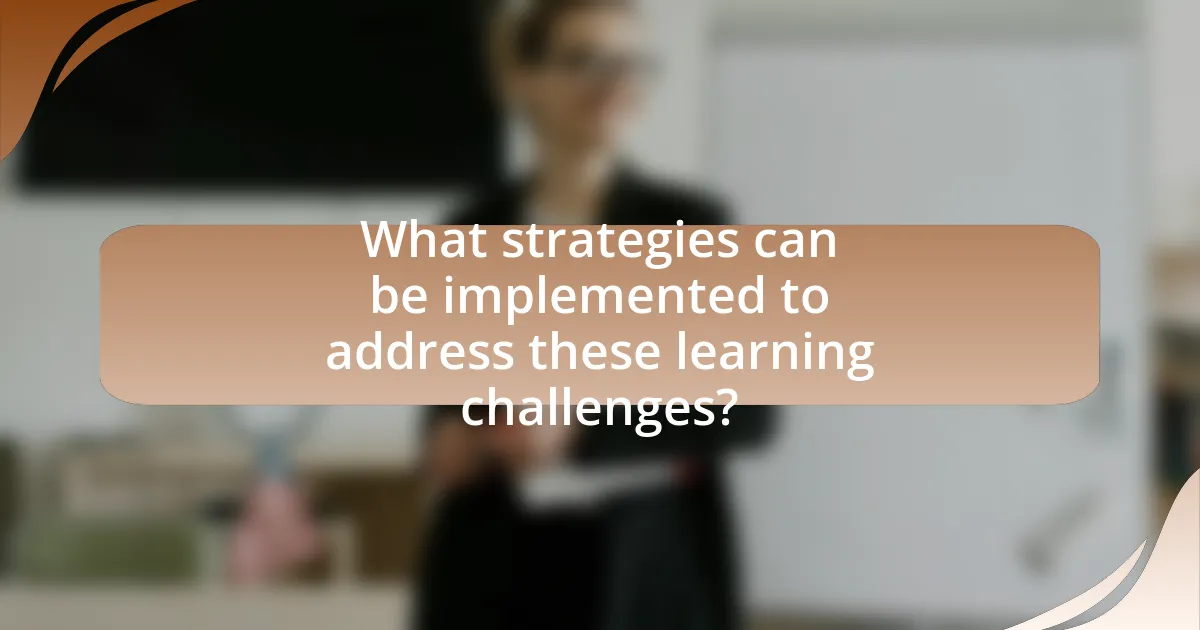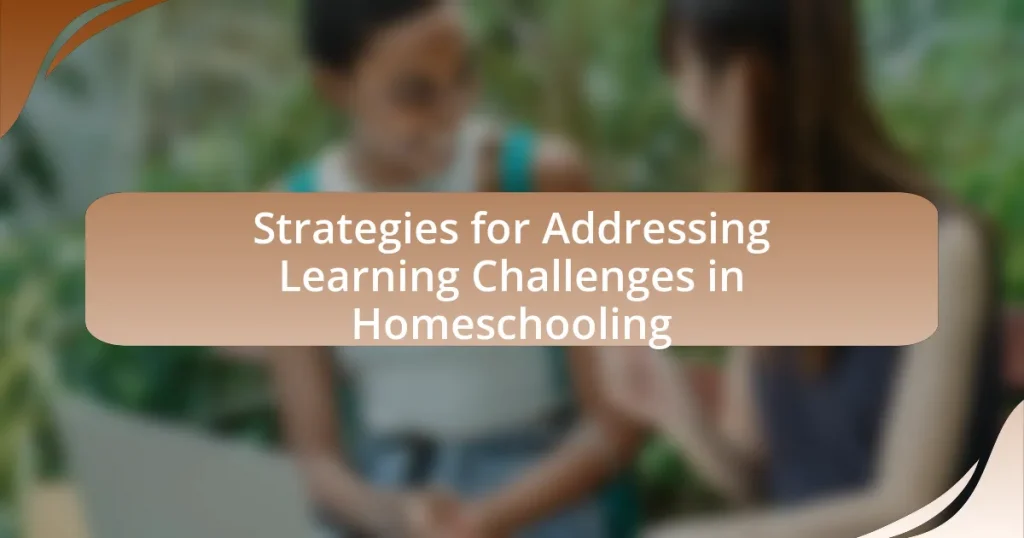The article focuses on strategies for addressing learning challenges in homeschooling, highlighting common obstacles such as lack of social interaction, inconsistent schedules, and varying parental expertise. It examines the impact of learning styles on educational effectiveness and discusses emotional and social challenges faced by homeschooled children, including feelings of isolation. The article also outlines effective teaching methods, the role of technology, and the importance of personalized learning plans in enhancing academic outcomes. Additionally, it provides practical strategies for creating a supportive learning environment, fostering motivation, and identifying when to seek external help for persistent learning challenges.

What are the common learning challenges faced in homeschooling?
Common learning challenges faced in homeschooling include lack of social interaction, difficulty in maintaining a structured schedule, and varying levels of parental expertise in different subjects. These challenges can hinder a child’s academic progress and social development. For instance, research indicates that homeschooled children may experience fewer opportunities for peer interaction, which can impact their social skills (source: “The Socialization of Children Who Are Homeschooled,” by R. J. McGowan, 2019). Additionally, parents may struggle to create a consistent learning environment, leading to gaps in education. A study by the National Center for Education Statistics found that 25% of homeschooling parents cited lack of time as a significant barrier to effective teaching (NCES, 2020).
How do learning styles impact homeschooling effectiveness?
Learning styles significantly impact homeschooling effectiveness by influencing how students engage with and absorb educational material. When homeschooling is tailored to match a child’s preferred learning style—such as visual, auditory, or kinesthetic—students are more likely to retain information and remain motivated. Research indicates that personalized learning approaches can lead to improved academic performance; for instance, a study published in the “Journal of Educational Psychology” found that students who received instruction aligned with their learning preferences scored higher on assessments compared to those who did not. This alignment fosters a more conducive learning environment, ultimately enhancing the overall effectiveness of homeschooling.
What are the different learning styles that may affect students?
The different learning styles that may affect students include visual, auditory, reading/writing, and kinesthetic. Visual learners benefit from diagrams, charts, and visual aids; auditory learners excel through listening and discussions; reading/writing learners prefer engaging with text and written materials; and kinesthetic learners thrive through hands-on activities and movement. Research by Fleming and Mills (1992) identifies these styles as part of the VARK model, which emphasizes the importance of tailoring educational approaches to accommodate diverse learning preferences, thereby enhancing student engagement and comprehension.
How can parents identify their child’s learning style?
Parents can identify their child’s learning style by observing how the child engages with different types of information and activities. For instance, children who prefer visual learning may benefit from diagrams and videos, while those who are auditory learners might excel with discussions and listening exercises. Additionally, kinesthetic learners often thrive when they can manipulate objects or engage in hands-on activities. Research indicates that recognizing these preferences can enhance educational outcomes; a study published in the Journal of Educational Psychology found that tailoring instruction to a child’s learning style can improve retention and understanding. By assessing their child’s responses to various teaching methods, parents can effectively determine the most suitable learning style for their child.
What emotional and social challenges do homeschooled children face?
Homeschooled children often face emotional and social challenges such as feelings of isolation and difficulty in forming peer relationships. These challenges arise because homeschooling typically limits daily interactions with a diverse group of peers, which can hinder the development of social skills. Research indicates that homeschooled children may experience higher levels of loneliness compared to their traditionally schooled counterparts, as they often lack opportunities for spontaneous social engagement found in conventional school settings. Additionally, the absence of a structured social environment can lead to difficulties in adapting to group dynamics and collaborative activities, which are essential for social development.
How can isolation affect a child’s learning experience?
Isolation can negatively impact a child’s learning experience by hindering social interaction and emotional development. Children who experience isolation often miss out on collaborative learning opportunities, which are crucial for developing communication skills and teamwork. Research indicates that social interactions enhance cognitive development; for instance, a study published in the journal “Child Development” found that children who engage in peer interactions demonstrate improved problem-solving skills and academic performance. Furthermore, isolation can lead to feelings of loneliness and anxiety, which can further impede a child’s ability to focus and engage with educational material.
What strategies can be used to enhance socialization for homeschooled children?
To enhance socialization for homeschooled children, parents can engage them in community activities, such as sports teams, clubs, and group classes. These activities provide structured environments where children can interact with peers, develop teamwork skills, and build friendships. Research indicates that participation in extracurricular activities significantly improves social skills and emotional well-being in children. For instance, a study published in the Journal of Educational Psychology found that children involved in organized sports exhibited higher levels of social competence compared to those who were not. Additionally, arranging playdates and joining homeschooling co-ops can further facilitate social interactions, allowing homeschooled children to connect with others in a supportive setting.
How do academic challenges manifest in a homeschooling environment?
Academic challenges in a homeschooling environment manifest through difficulties in curriculum adherence, inconsistent assessment of student progress, and socialization issues. Homeschooling often lacks the structured environment of traditional schools, leading to potential gaps in knowledge and skills due to the absence of standardized testing and accountability measures. Research indicates that homeschooled students may struggle with self-discipline and motivation, which can hinder their academic performance. Additionally, the limited interaction with peers can affect their social development, further complicating their educational experience.
What subjects are typically more challenging for homeschooled students?
Mathematics and science subjects are typically more challenging for homeschooled students. These subjects often require a strong foundation in abstract concepts and problem-solving skills, which can be difficult to teach without structured classroom environments. Research indicates that homeschooled students may struggle with advanced topics in mathematics, such as algebra and calculus, due to the lack of peer interaction and immediate feedback that traditional schooling provides. Additionally, subjects like chemistry and physics often necessitate hands-on experiments and lab work, which can be challenging to replicate in a home setting.
How can parents assess their child’s academic progress effectively?
Parents can assess their child’s academic progress effectively by utilizing a combination of regular assessments, tracking assignments, and maintaining open communication with their child. Regular assessments, such as quizzes and standardized tests, provide measurable data on a child’s understanding of the material. Tracking assignments helps parents monitor completion and quality, offering insights into areas where the child may struggle. Open communication encourages children to express their feelings about their learning experiences, allowing parents to identify challenges and adjust their teaching strategies accordingly. Research indicates that consistent monitoring and feedback significantly enhance student performance, as noted in studies by the National Center for Education Statistics, which highlight the importance of parental involvement in academic success.

What strategies can be implemented to address these learning challenges?
To address learning challenges in homeschooling, implementing personalized learning plans is essential. These plans tailor educational content to the individual needs, strengths, and interests of each student, enhancing engagement and comprehension. Research indicates that personalized learning can lead to improved academic outcomes, as evidenced by a study from the Bill & Melinda Gates Foundation, which found that students in personalized learning environments showed greater gains in math and reading compared to their peers in traditional settings. Additionally, incorporating varied instructional methods, such as hands-on activities, visual aids, and technology, can cater to different learning styles, further supporting students in overcoming challenges.
How can personalized learning plans benefit homeschooled children?
Personalized learning plans can significantly benefit homeschooled children by tailoring educational experiences to their individual learning styles, interests, and paces. This customization allows children to engage more deeply with the material, leading to improved retention and understanding. Research indicates that personalized learning can enhance student motivation and achievement; for instance, a study by the Bill & Melinda Gates Foundation found that personalized learning approaches can lead to a 20% increase in student performance compared to traditional methods. By focusing on the unique needs of each child, personalized learning plans foster a more effective and enjoyable learning environment, ultimately supporting better educational outcomes.
What elements should be included in a personalized learning plan?
A personalized learning plan should include specific learning goals, assessment methods, instructional strategies, and progress monitoring. Specific learning goals define what the learner aims to achieve, ensuring clarity and focus. Assessment methods outline how progress will be measured, which can include quizzes, projects, or observations. Instructional strategies detail the teaching approaches tailored to the learner’s needs, such as differentiated instruction or hands-on activities. Progress monitoring involves regular check-ins to evaluate the learner’s advancement toward the goals, allowing for adjustments to the plan as necessary. These elements collectively create a structured and adaptable framework that addresses individual learning challenges effectively.
How can parents adapt the learning plan based on progress?
Parents can adapt the learning plan based on progress by regularly assessing their child’s understanding and performance in various subjects. This involves using formative assessments, such as quizzes and observations, to identify areas where the child excels or struggles. For instance, if a child demonstrates mastery in math but struggles with reading comprehension, parents can adjust the learning plan to allocate more time and resources to reading activities. Research indicates that personalized learning approaches, which respond to individual progress, can significantly enhance educational outcomes, as shown in studies by the Bill & Melinda Gates Foundation, which highlight the effectiveness of tailored educational strategies.
What role does technology play in overcoming learning challenges?
Technology plays a crucial role in overcoming learning challenges by providing diverse tools and resources that cater to individual learning needs. For instance, adaptive learning software personalizes educational content based on a student’s pace and understanding, which has been shown to improve engagement and retention. Research from the Bill & Melinda Gates Foundation indicates that technology-enhanced learning environments can lead to a 20% increase in student performance compared to traditional methods. Additionally, online platforms facilitate access to a wide range of educational materials and expert support, enabling learners to overcome barriers such as geographical limitations or resource scarcity.
What are the best educational tools and resources available for homeschooling?
The best educational tools and resources for homeschooling include online platforms like Khan Academy, which offers free courses across various subjects, and curriculum providers such as Time4Learning, known for its comprehensive lesson plans. Additionally, resources like the National Home Education Research Institute provide research and statistics supporting the effectiveness of homeschooling. These tools are designed to cater to diverse learning styles and needs, ensuring that students receive a well-rounded education tailored to their individual challenges.
How can online communities support homeschooling families?
Online communities can support homeschooling families by providing access to resources, shared experiences, and emotional support. These platforms enable families to exchange educational materials, lesson plans, and teaching strategies, which can enhance the learning experience. Research indicates that 85% of homeschooling parents report feeling more confident in their teaching abilities when they engage with online support groups. Additionally, these communities foster connections among families facing similar challenges, reducing feelings of isolation and promoting collaboration.
What teaching methods can be effective in addressing learning challenges?
Effective teaching methods for addressing learning challenges include differentiated instruction, scaffolding, and the use of multisensory approaches. Differentiated instruction tailors teaching strategies to meet individual student needs, allowing for varied content, processes, and products based on learners’ readiness levels, interests, and learning profiles. Scaffolding provides temporary support structures that help students achieve understanding and independence, gradually removing assistance as competence increases. Multisensory approaches engage multiple senses, enhancing retention and understanding by integrating visual, auditory, and kinesthetic learning styles. Research indicates that these methods can significantly improve learning outcomes for students facing challenges, as evidenced by studies showing increased engagement and achievement in diverse learning environments.
How can hands-on learning enhance understanding for struggling students?
Hands-on learning enhances understanding for struggling students by engaging them in active participation, which reinforces concepts through practical application. This method allows students to connect theoretical knowledge with real-world experiences, making learning more relevant and memorable. Research indicates that students who engage in hands-on activities demonstrate improved retention and comprehension; for instance, a study published in the Journal of Educational Psychology found that students who participated in hands-on learning scored 20% higher on assessments compared to those who learned through traditional methods. This approach caters to various learning styles, particularly kinesthetic learners, and fosters critical thinking and problem-solving skills, further supporting academic success.
What are the benefits of incorporating project-based learning in homeschooling?
Incorporating project-based learning in homeschooling enhances student engagement and fosters critical thinking skills. This approach allows learners to explore real-world problems, promoting deeper understanding and retention of knowledge. Research indicates that students involved in project-based learning demonstrate improved collaboration and communication skills, as they often work in teams to complete projects. A study by Thomas Markham published in “Edutopia” highlights that project-based learning can lead to higher academic achievement and increased motivation among students.

How can parents ensure a supportive learning environment at home?
Parents can ensure a supportive learning environment at home by creating a structured and resource-rich space dedicated to learning. This involves setting specific times for study, minimizing distractions, and providing access to educational materials such as books, technology, and learning tools. Research indicates that a well-organized environment can enhance focus and motivation, leading to improved academic performance. For instance, a study published in the Journal of Educational Psychology found that students who had designated study areas performed better academically than those who did not.
What strategies can parents use to create a structured learning environment?
Parents can create a structured learning environment by establishing a consistent daily schedule that includes designated times for learning, breaks, and recreational activities. This approach helps children understand expectations and develop a routine that promotes focus and productivity. Research indicates that children thrive in environments where structure is present, as it fosters a sense of security and enhances their ability to learn effectively. For instance, a study published in the Journal of Educational Psychology found that students with structured routines showed improved academic performance and reduced anxiety levels. By implementing a clear timetable, parents can significantly enhance their child’s learning experience in a homeschooling setting.
How can routines and schedules improve learning outcomes?
Routines and schedules can significantly improve learning outcomes by providing structure and predictability, which enhances focus and retention. Research indicates that students who follow consistent routines demonstrate better time management skills and increased academic performance. For instance, a study published in the Journal of Educational Psychology found that students with established study schedules scored higher on assessments compared to those without such routines. This structured approach minimizes distractions and fosters a conducive learning environment, ultimately leading to improved educational results.
What role does a dedicated learning space play in a child’s education?
A dedicated learning space significantly enhances a child’s education by providing an environment specifically designed for focus and engagement. This tailored setting minimizes distractions and fosters a sense of routine, which is crucial for effective learning. Research indicates that children perform better academically when they have a designated area for study, as it helps them associate that space with learning activities. For instance, a study published in the Journal of Educational Psychology found that students with a consistent study environment showed improved concentration and retention of information compared to those without such a space. Thus, a dedicated learning space plays a vital role in optimizing educational outcomes for children.
How can parents foster motivation and engagement in their children?
Parents can foster motivation and engagement in their children by creating a supportive and stimulating learning environment. This involves setting clear expectations, providing choices in learning activities, and encouraging autonomy, which research shows enhances intrinsic motivation. For instance, a study published in the Journal of Educational Psychology found that children who are given opportunities to make choices in their learning are more engaged and motivated. Additionally, parents can use positive reinforcement to celebrate achievements, which further boosts motivation and reinforces a growth mindset.
What techniques can be used to encourage a love for learning?
To encourage a love for learning, techniques such as fostering curiosity, providing autonomy, and incorporating hands-on activities can be employed. Fostering curiosity involves presenting topics in an engaging manner, which can spark interest and motivate learners to explore further. Providing autonomy allows learners to make choices in their learning process, enhancing their investment and enthusiasm. Incorporating hands-on activities, such as experiments or creative projects, makes learning interactive and enjoyable, reinforcing concepts through practical application. Research indicates that these techniques can significantly enhance motivation and engagement in educational settings, as evidenced by studies showing that students who are given choices in their learning demonstrate higher levels of interest and achievement.
How can parents celebrate achievements to boost confidence?
Parents can celebrate achievements by acknowledging and praising their child’s efforts and successes, which significantly boosts confidence. Specific actions include verbal affirmations, creating a reward system, and organizing small celebrations for milestones. Research indicates that positive reinforcement enhances self-esteem and motivation in children, as noted in studies by the American Psychological Association, which highlight the correlation between recognition and increased confidence levels. By consistently celebrating achievements, parents foster a supportive environment that encourages further learning and growth.
What are some best practices for troubleshooting learning challenges?
Best practices for troubleshooting learning challenges include identifying specific areas of difficulty, implementing targeted interventions, and regularly assessing progress. Identifying specific areas of difficulty allows educators or parents to focus on the root causes of learning challenges, such as comprehension issues or skill gaps. Implementing targeted interventions, such as personalized learning plans or adaptive resources, can effectively address these challenges. Regularly assessing progress through formative assessments or feedback mechanisms ensures that the interventions are effective and allows for timely adjustments. Research indicates that targeted interventions can improve learning outcomes significantly, as evidenced by studies showing that personalized learning approaches lead to higher student engagement and achievement.
How can parents identify when to seek external help for their child?
Parents can identify when to seek external help for their child by observing significant changes in behavior, academic performance, or emotional well-being. If a child consistently struggles with basic concepts, shows signs of frustration or anxiety related to learning, or exhibits withdrawal from social interactions, these may indicate a need for professional support. Research shows that early intervention can lead to better outcomes; for instance, the National Center for Learning Disabilities emphasizes that timely assistance can prevent further academic decline. Additionally, if parents notice that their child is not responding to typical homeschooling strategies or resources, it may be a signal to consult educational specialists or mental health professionals.
What resources are available for parents facing persistent learning challenges?
Parents facing persistent learning challenges can access a variety of resources designed to support their children’s educational needs. These resources include specialized educational programs, online learning platforms, and support groups. For instance, organizations like the National Center for Learning Disabilities provide information and tools tailored for parents, while platforms such as Khan Academy offer free educational resources that cater to different learning styles. Additionally, local school districts often have special education services that can assist families in navigating learning challenges. Research indicates that early intervention and tailored educational strategies significantly improve outcomes for children with learning difficulties, reinforcing the importance of utilizing these available resources.










